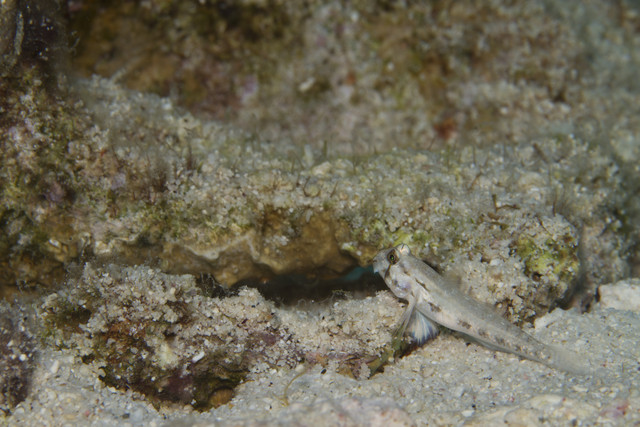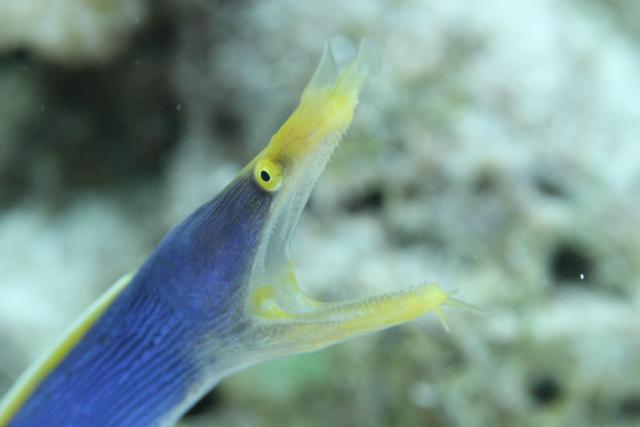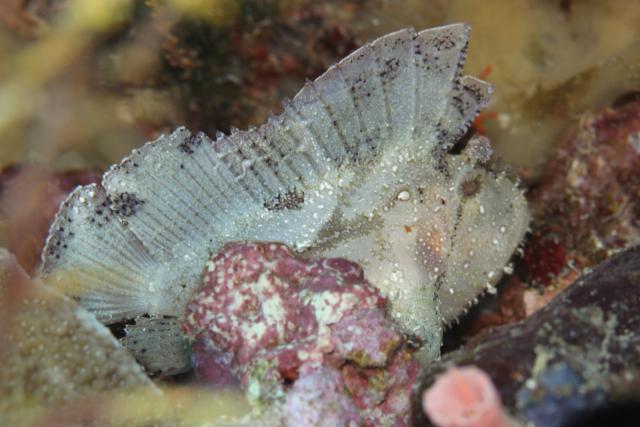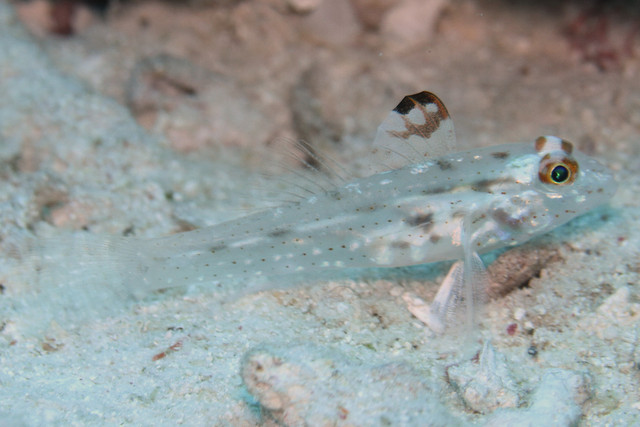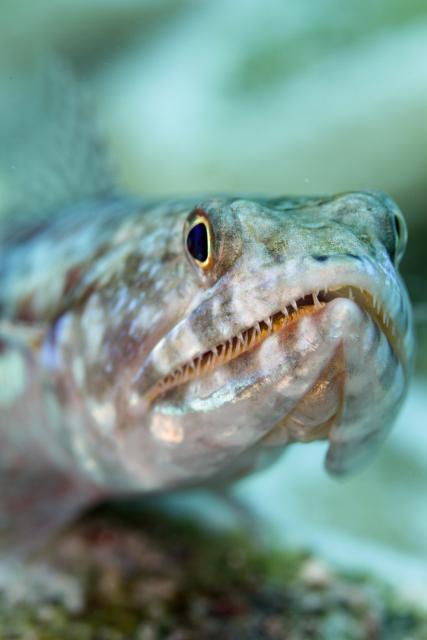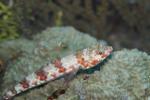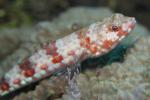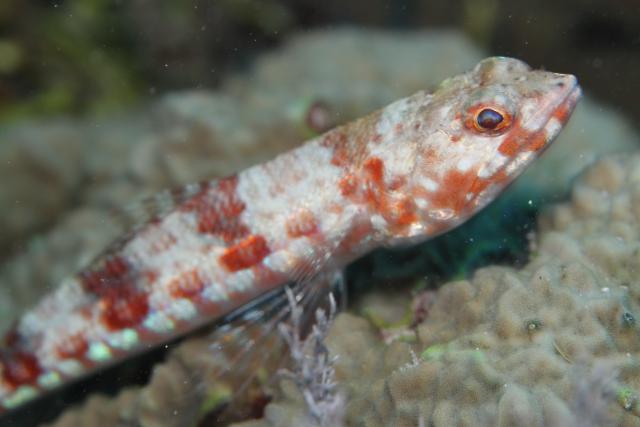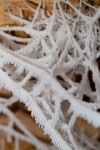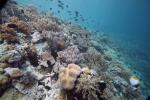fish
Caribbean Explorer: Goldspot Goby
ktuli — Wed, 10/12/2011 - 20:24
Ok - till slogging my way through hundreds of RAW conversions, so just stopping by tonight to post another quick shot. Today, we have a Goldspot Goby (Gnatholepis thompsoni). These are small little fish - about an inch or two max, that live on the sandy bottoms of the reef. If approached slowly, they will sometimes sit nicely like this little fellow and allow for a decent photo.
Technical Data: Canon EOS 7D, Canon EF 100mm f/2.8L Macro IS USM, 1/120th sec at f/16. Image Stabilization on. ISO 100. Ikelite Housing and Port with Ikelite 161 Strobe in TTL Mode. Raw conversion in Photoshop CS5.
Stay tuned! The octopodes are coming soon!
- Bill
Wakatobi: Googlie Eyes
ktuli — Sun, 09/18/2011 - 21:17
It is getting late, and I'm fairly tired, so just a quick shot to share tonight...
Technical Data: Canon EOS 7D, Canon EF 100mm f/2.8L Macro IS USM, 1/32th sec at f/11.3. Image Stabilization on. ISO 400 (Auto). Ikelite Housing and Port with Ikelite DS161 Strobe in TTL Mode. Removed color cast in Photoshop Elements 8 (mouseover for original).
Dive trip is coming soon! Can't wait to get a bunch of new shots to share.
- Bill
Wakatobi: Blue Ribbon Eel Close-Up
ktuli — Thu, 08/18/2011 - 21:16
Another dive photo today...
Technical Data: Canon EOS 7D, Canon EF 100mm f/2.8L Macro IS USM, 1/170th sec at f/8. Image Stabilization on. ISO 2500 (Auto). Ikelite Housing and Port with Ikelite 161 Strobe in TTL Mode. No post production.
Getting a little stir crazy here if you can't tell.
- Bill
Wakatobi: The Elusive Damselfish
ktuli — Wed, 08/17/2011 - 21:23
I've looked for this fish in my identification book dozens of times. As it turns out, there appear to be local variants, and the one in the ID book just doesn't look much like this.
These little fish are called Indian or Cloudy Dascyllus (Dascyllus carneus). They are a small damselfish up to about 2.5 inches, but often as you can see a group of them range from every size. In Wakatobi, they were on pretty much every table coral like this, and would dart back into the coral as you approached. I managed to get this shot by slowly approaching the coral from below and coming up so I was eye level with the fish.
Technical Data: Canon EOS 7D, Canon EF 100mm f/2.8L Macro IS USM, 1/40th sec at f/8. Image Stabilization on. ISO 400 (Auto). Ikelite Housing and Port with Ikelite 161 Strobe in TTL Mode. Auto-smartfix in Adobe Photoshop Elements 8 (mouseover for original).
Have I mentioned that I really want to get back in the water sometime soon?
- Bill
Wakatobi: Leaf Scorpionfish
ktuli — Wed, 06/22/2011 - 20:42
Just a quick shot to share today. This cryptically camouflaged critter is a Leaf Scorpionfish (Taenianotus triacanthus). They are sometimes so hard to spot that one member of our group was actually looking past the one we were pointing to, trying to figure out what was hiding behind it that we could have been pointing to! These little guys even sway in the water to mimic a dead leaf or seaweed.
Technical Data: Canon EOS 7D, Canon EF 100mm f/2.8L Macro IS USM, 1/25th sec at f/8. Image Stabilization on. ISO 400 (Auto). Ikelite Housing and Port with Ikelite 161 Strobe in TTL Mode. Auto-smartfix and Removed Color Cast in Photoshop Elements 8.0 (mouseover for original)
I really wish I could go diving soon. Like, really soon.
- Bill
Wakatobi: Closed Anemone
ktuli — Tue, 05/17/2011 - 21:01
Most people know what an anemone fish does when it is scared... it goes and hides in the protective tentacles of its host anemone.
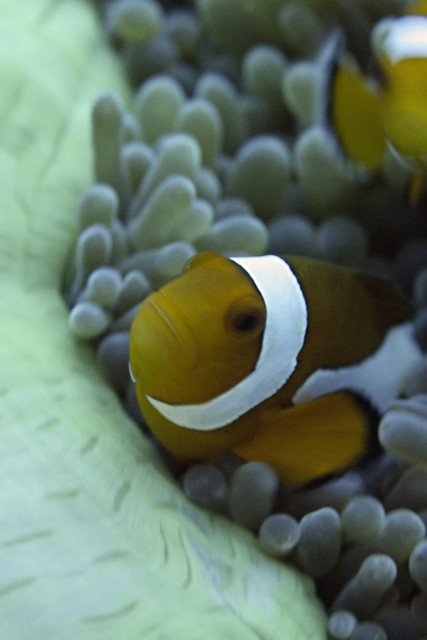
But what about when the anemone gets scared?
It just closes up shop, and that usually means the anemone fish need to push and shove to get some protection.
Technical Data: Canon EOS 7D, Canon EF 100mm f/2.8L Macro IS USM, 1/25th sec at f/8. Image Stabilization on. ISO 3200 (Auto). Ikelite Housing and Port with Ikelite 161 Strobe in TTL Mode. Removed Color Cast, Auto Smart Fix in Photoshop Elements 8.0 (mouseover for original).
As you can see when you mouseover the image, the original shot had a pretty bad blue color cast - likely because the flash did not fire (I often would rapid fire shots, and by the end of the series the flash would be recycling). Luckily, Photoshop does a decent job of cleaning up that color cast.
I don't know why I keep skipping my usual critiques, but I guess I just feel like sharing photos recently - perhaps I'll get back to the regular routine soon.
This one obviously isn't the best focus I've ever achieved, but I still think the shot works well. I also looked at trying to find a different crop for it (mainly to eliminate the partial fish in the top right corner, but couldn't find one I liked. Despite its flaws, I still really like the shot.
If you haven't seen them before, you might want to check these older posts with other anemone fish: False Clownfish and the early Sneak Peak (part 2).
- Bill
Wakatobi: Signalfin Goby
ktuli — Tue, 05/17/2011 - 20:10
I was flipping through my Wakatobi shots again tonight, and I stumbled upon this one of a Signalfin Goby (Coryphopterus signipinnis).
These guys are fairly tiny little fish - maxing out at about 1.25" - and are extremely skittish. To be honest, I don't even remember taking this photo.
Technical Data: Canon EOS 7D, Canon EF 100mm f/2.8L Macro IS USM, 1/50th sec at f/8. Image Stabilization on. ISO 400 (Auto). Ikelite Housing and Port with Ikelite 161 Strobe in TTL Mode. Removed Color Cast, Adjust Brightness -50, Contrast +10 in Photoshop Elements 8.0 (mouseover for original).
I know the shot is extremely over-exposed with the semi-translucent body of the fish and the bright white sand of the reef, even with having pulled the brightness back in Photoshop, but I am pretty pleased with the crisp focus and clarity (something I struggled with on this trip) - especially for such a small skittish subject.
Drop me a line and let me know what you think of the shot, and of the post production work.
- Bill
Wakatobi: Reef Lizardfish
ktuli — Mon, 05/09/2011 - 19:02
I've found myself thinking back to my Wakatobi trip a lot recently. I really long to be slowly sinking below the surface of some crystal clear blue water, camera in hand, ready to go find some interesting reef inhabitant.
We saw plenty of these Reef Lizardfish (Synodus variegatus) on almost every dive. Most were in the range of 8-10 inches in length and would sit motionless on top of outcroppings. In general, they would let you approach within a few feet of them before they darted off to hide, so getting relatively close like this was not too challenging as long as you moved in slowly.
As you can see, they had tons of sharp little curved teeth that despite being tiny were kind of impressively intimidating. That, coupled with their jaw structure illustrates that they are an ambush predator. They lie still waiting for an unsuspecting fish to swim a little too close, then - *WHAM!* - lunge forward with that large mouth, using those curved teeth (much like a lizard) to keep their prey from escaping.
Cool little fish.
Technical Data: Canon EOS 7D, Canon EF 100mm f/2.8L Macro IS USM, 1/170th sec at f/8. Image Stabilization on. ISO 500 (Auto). Ikelite Housing and Port with Ikelite 161 Strobe in TTL Mode. Auto-smartfix and Removed Color Cast in Photoshop Elements 8.0 (mouseover for original)
Why This Photo: As I said, I was quite impressed with those teeth, and they help to give the fish its lizard like namesake, so I wanted to capture a shot that showed those teeth in particular.
What Works: The focus is right on the fish's eye, and more importantly on those razor sharp teeth. The varying diagonal lines (the reef shelf, the lizard fish's back, its jawline, etc) continuously lead the viewer's eyes through the frame and back again.
What Doesn't Work: The aperture could have been stopped down just a little more (perhaps to f/11) for more depth of field to show more of the fish in focus - though just enough to keep the head in focus to avoid there being distracting elements to take away from the teeth being the main point of interest. Also, potentially a horizontal format would have worked better for this long fish.
As a bonus, I have several other shots of these fish to share... though, for some reason, I liked to cut off their tails from the shots. I don't know why, but looking through all of my lizardfish shots, they are pretty much all like that. Guess I'll have to go back and try it again... ;) Just mouseover the thumbnail to display the larger version.
And as you can see, I also apparently only approach these fish from their right sides... Weird. Anyway, what I was trying to illustrate was the variety in their colors... ranging from light tan, to dark brown, and even to a bright red.
Like I said, cool little fish.
- Bill
Wakatobi: Pair of Hawkfish
ktuli — Thu, 03/31/2011 - 20:20
Just stopping by to share a couple different hawkfish we encountered while diving in Wakatobi. Enjoy.
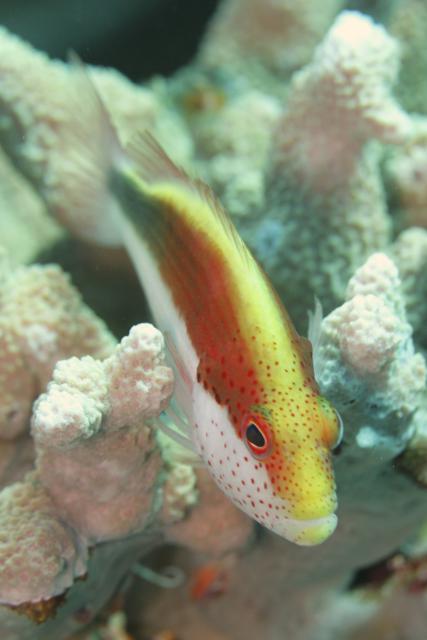
Freckled Hawkfish (Paracirrhites forsteri)
Technical Data: Canon EOS 7D, Canon EF 100mm f/2.8L Macro IS USM, 1/100th sec at f/8. Image Stabilization on. ISO 400 (Auto). Ikelite Housing and Port with Ikelite DS161 Strobe in TTL Mode. Remove color cast and cropped in Photoshop Elements 8.0.
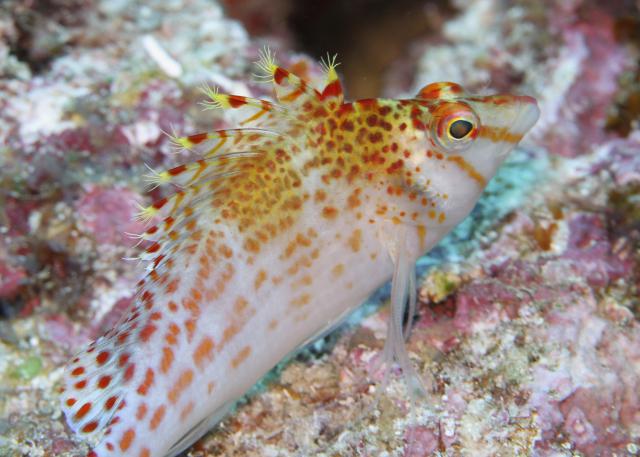
Dwarf Hawkfish (Cirrhitichthys falco)
Technical Data: Canon EOS 7D, Canon EF 100mm f/2.8L Macro IS USM, 1/40th sec at f/8. Image Stabilization on. ISO 400 (Auto). Ikelite Housing and Port with Ikelite DS161 Strobe in TTL Mode. Remove color cast and cropped in Photoshop Elements 8.0.
Some cool little fish, we saw plenty of them on the reefs - especially the dwarf hawkfish whose camouflage allows them to sit right out in the open.
- Bill
Wakatobi: Fire Dartfish
ktuli — Wed, 03/23/2011 - 20:59
Alright, back to the dive photography (how I wish that meant back to taking dive photos!) to try and get back into my routine of regular posts.
Today's little guy (or girl - can tell for certain what sex it is) is a Fire Dartfish (Nemateleotris magnifica). They are small (about three inches max) and very skittish, so getting close to fill this much of the frame with one is a bit of a challenge.
Technical Data: Canon EOS 7D, Canon EF 100mm f/2.8L Macro IS USM, 1/130th sec at f/8. Image Stabilization on. ISO 800 (Auto). Ikelite Housing and Port with Ikelite 161 Strobe in TTL Mode. Auto-smartfix and brightness reduced 10% in Photoshop Elements 8.0
What Works: The best part of this photo for me is how the fish jumps off the screen - there is just a three dimensionality to the shot that really pops! The colors of the dartfish are spot on, and the depth of field provides a nice soft background with just enough detail to show some of the liverock in the background.
What Doesn't Work: First, the dartfish itself is a bit washed out - those bright white scales are just so easily over-exposed. Additionally, the positioning of the fish in the frame is less than ideal with it looking out of the frame.
What do you think? Drop me a comment and let me know.
- Bill

